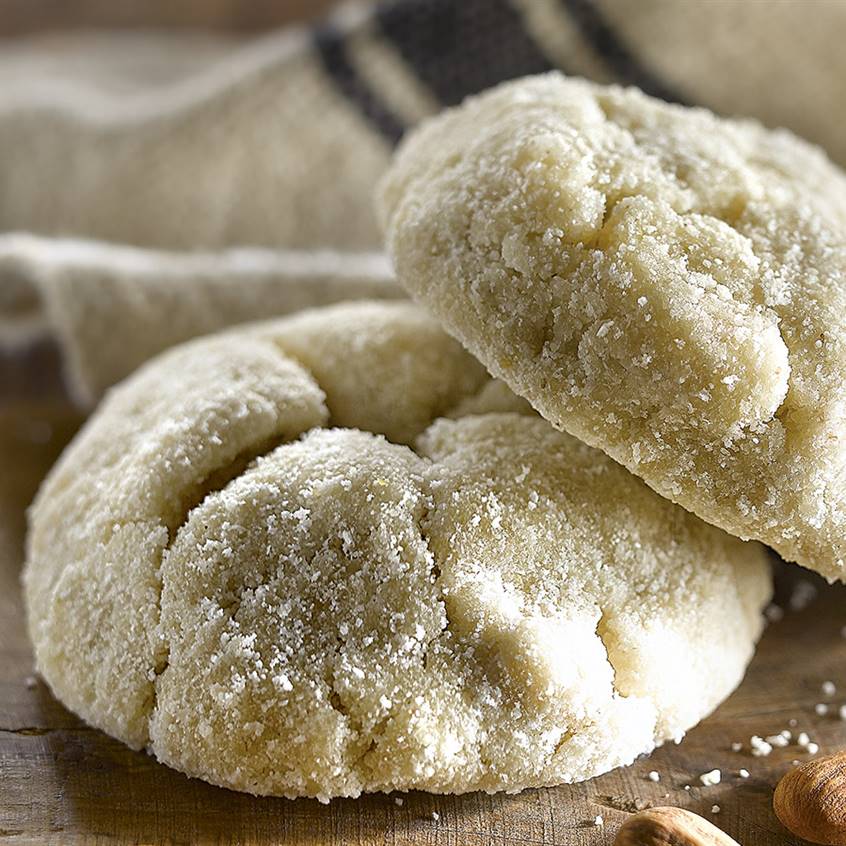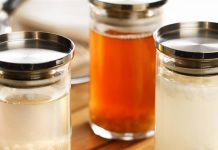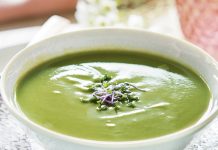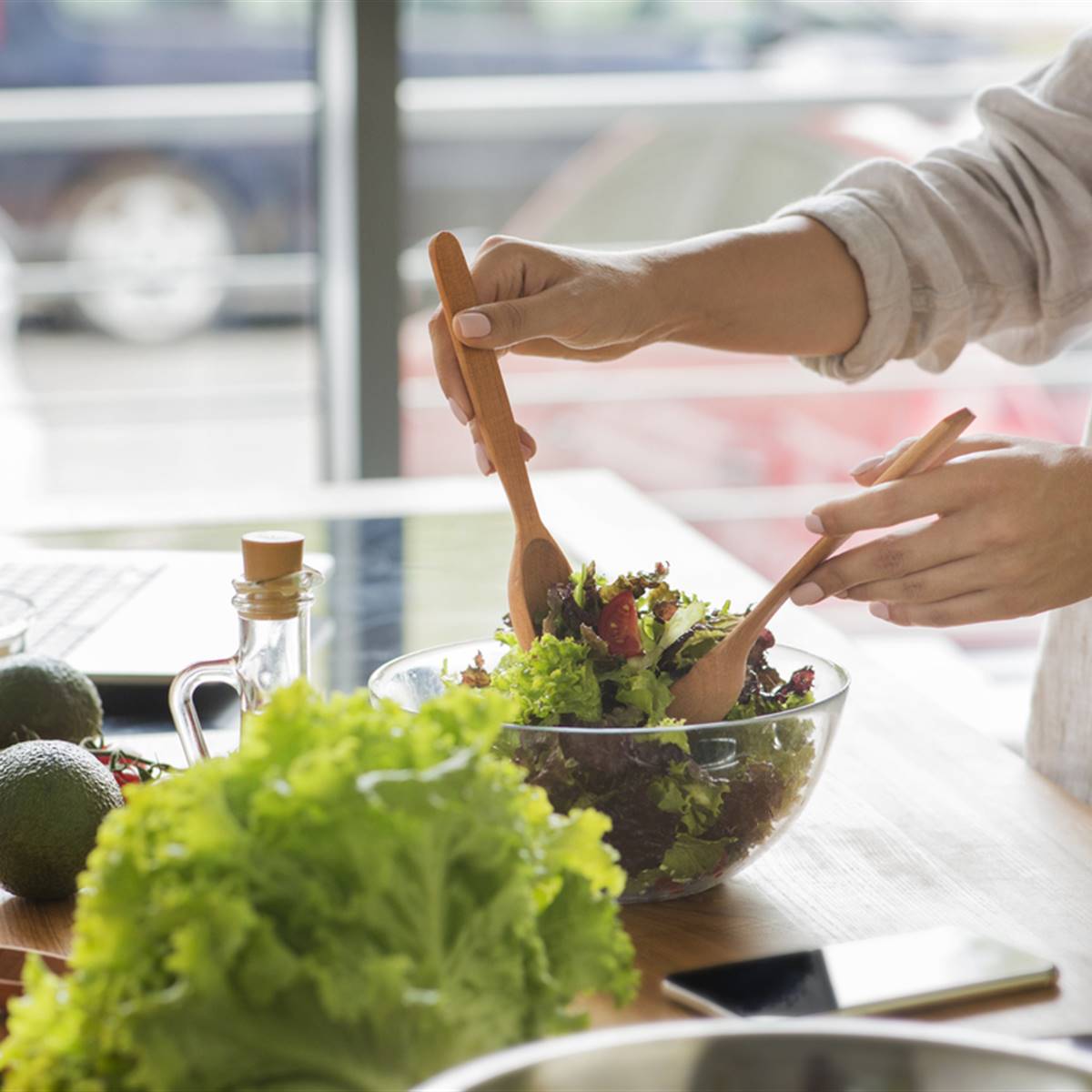Raw breads are not baked. They only dehydrate at low temperature. This way they keep their nutrients intact and assimilate better. With nuts, seeds, sprouts, vegetables… A delight of ‘raw’ cooking that is worth doing at home.

WHITE ALMOND AND COCONUT BREAD
Ingredients for two breads:
- 50 g young coconut pulp
- 1 cup raw, activated, peeled and dehydrated almonds
- 1 tablespoon psyllium husks
- 6 tablespoons coconut flour
- A pinch of salt
Preparation (20 min + 18 h):
- Pass through the blender all the ingredients, except the coconut flour, until a smooth puree is obtained.
- In a bowl pour the mixture and gradually add four tablespoons of coconut flour while stirring. This mass, without lumps, is divided into two.
- Sprinkle the work surface with the remaining coconut flour and shape two rolls on top.
- They are placed on baking paper or the non-stick sheets of the dehydrator and dehydrated for 12 hours.
- At 12 o’clock, the paper or foil is removed and left 6 more hours directly in the dehydrator trays.
A bread provides: Calories: 639
Carbohydrates: 24 g Proteins:
18 g Fat: 52 g
OAT FOCACCIA
Ingredients for 2 focaccias:
- 1 cup sourdough of oat sprouts
- 1 cup almonds, activated, peeled and dehydrated
- 1 cup golden flax, activated, dried and ground
- 1 cup oat sprouts, dehydrated and ground
- 1 tablespoon muscovado sugar and <> tablespoon sea salt
- 4 tablespoons ground almonds (for kneading)
- some cherry tomatoes
- Dead olives
- some rosemary leaves
- extra virgin olive oil for garnish
Preparation (30 min + 24 h):
- To make the dough, half a cup of fresh oat sprouts is ground in half a cup of water and fermented for three days in a covered glass jar (leaving half empty).
- The dry ingredients, minus the almond and rosemary, are crushed into flour. Add the wet ingredients and crush again until the dough is obtained.
- Rosemary is added to the dough, divided in two and shaped into focaccia on a surface sprinkled with almond. It is decorated with rosemary, cherries, olives and oil.
- They are dehydrated for 12 hours on baking paper or the sheets of the dehydrator. They are then dehydrated directly on the trays for 12 more hours.
Half focaccia provides: Calories: 638 Carbohydrates: 30 g Proteins:
18
g Fat: 46 g
MANGO CRACKERS AND PURPLE FLAX SEEDS
Ingredients for 20 crackers:
- 1 mango, peeled and boned
- 2 cups golden flax seeds, activated
- 1/4 teaspoon sea or Himalayan salt
- 1/4 teaspoon freshly ground black pepper
- 10 fresh basil leaves
- half a teaspoon ground turmeric
- the juice of half a lemon
Preparation (20 min + 12 h):
- In a robot or kitchen processor, you beat everything except flax and basil until you get a smooth puree.
- Pour into a bowl, mix with flax seeds with the help of a wooden spoon and incorporate basil cut into very thin strips (in chiffonade).
- It is spread on baking paper or the sheets of the dehydrator in thin layers and dehydrated 8 hours.
- It is turned over and dehydrated for 4 more hours.
- It is cut with a sharp knife to get regular crackers, or with the hands if you want irregular.
A cracker provides: Calories: 95
Carbohydrates: 3 g Proteins:
3 g Fat: 7 g
BRAZIL NUT ROLLS WITH HINTS OF GARLIC
Ingredients for 4 breads:
- 2 cups Brazil nuts, activated and washed
- 1 cup golden flax, activated, dried and ground
- 2 tablespoons psyllium husks
- 2 tablespoons pumpkin seeds
- 4 tablespoons extra virgin olive oil
- 1 tablespoon sea or Himalayan salt
- 1 tablespoon coconut sugar
- 1 garlic clove, crushed and skinned
- 4 tablespoons coconut flour
Preparation (20 min + 48 hours):
- In a processor or food processor, the nuts are crushed well along with the oil, salt, coconut sugar and garlic. Add the rest of the ingredients, except the flour, and continue crushing until a modelable dough is obtained.
- The dough is divided into 4 portions and, on a surface sprinkled with flour, the rolls are formed.
- They are dehydrated for 24 hours on baking paper or the sheets of the dehydrator and then directly on the trays for another 24 hours.
A bread provides: Calories: 798
Carbohydrates: 26 g Proteins:
20 g Fat: 69 g
FLAX SEED AND PUMPKIN BREAD
Ingredients for 20 breads:
- 3 cups brown or gold flax, activated, dehydrated and freshly ground
- 3 apples, with skin and seeds
- 125 ml seawater
- 1 teaspoon black pepper, freshly ground
- half cup activated and washed pumpkin seeds
Preparation (15 min + 12 hours):
- The apples are crushed in a robot or kitchen processor together with the seawater and pepper until a very soft puree is obtained without lumps.
- Then add the flax and crush again until everything is well mixed and homogeneous.
- Finally, the pumpkin seeds are added and mixed with a wooden spoon.
- The mass obtained is spread, 1 cm thick, on baking paper or the non-stick sheets of the dehydrator.
- It is dehydrated 8 hours, turned over and left 4 hours more directly on the trays.
- Once done, it is cut with a knife into 8 rectangular portions as similar as possible.
A bread provides: Calories: 165
Carbohydrates: 7 g Proteins:
5 g Fat: 11 g
PUMPKIN AND SUN-DRIED TOMATO ROLLS
Ingredients for 8 breads:
- 300 g well-crushed raw pumpkin
- 6 sun-dried tomatoes, rehydrated with filtered water
- 2 cups sunflower seeds, activated and washed
- 1 cup golden flax, activated, dried and ground
- 2 garlic, crushed and skinned
- 1 apple, with skin and seeds
- 4 tablespoons extra virgin olive oil
- 1 teaspoon ground turmeric
- 2 tablespoons psyllium husks
- 4 tablespoons activated, dehydrated and freshly ground almonds
Preparation (30 min + 32 h):
- Crush everything, except the almonds, in a robot or kitchen processor until a soft but modelable dough is obtained.
- It is divided into eight and, on a surface sprinkled with ground almonds, the breads are formed.
- Dehydrate 8 hours on baking paper or the sheets of the dehydrator.
- Then continue dehydration directly on the trays for 24 more hours.
A bread provides: Calories: 460
Carbohydrates: 19 g Proteins:
17 g Fat: 34 g
KEYS TO PREPARING AND USING RAW BREADS
When making the bread, we can add the fresh sprouts as is or we can dehydrate them and store them for months in tightly closed glass jars. When we decide to make bread, we can recover and grind them. This way we avoid the slow germination process every time we want to prepare a couple of rolls.
Sprouted cereals and pseudocereals are not the only basis of raw breads. They can also be made with other seeds preferably activated and / or germinated – sunflower, pumpkin, flax – and with activated nuts – almonds, walnuts, Brazilian coquitos, hazelnuts, pine nuts …
ACTIVATE SEEDS
It is important to wash and activate all seeds and nuts, as they also contain enzyme inhibitors similar to cereal phytates (the function of these compounds is to prevent the seed from germinating while the humidity and temperature conditions are not adequate, as well as to defend itself from its predators). It also favors its digestibility and increases its nutritional properties.
Mucilaginous seeds – flax, chia – are an exception: we can use them activated, germinated or unactivated. These are not the only foods that make up a raw bread, they can also contain vegetables, fruits, aromatic herbs, roots, oils, algae, flowers, mushrooms …
THE “ESSENE BREAD”
Raw bread is not a modern, eccentric invention. The idea is very old. In fact, it is called “Essene bread” because it is believed that it was a staple food of this Jewish community around the second century BC that apparently based its diet on the consumption of vegetables, fruits, seeds and sprouts.
In the Bible, in Ezekiel 4:9, its ingredients are described: “wheat, barley, beans, lentils, millet, and spelt.” As we have seen, to make a raw bread, the grains are activated and germinated, mixed with the rest of the ingredients, shaped – generally, rolls of about 10 cm in diameter – and dehydrated.
In summer, we can dehydrate our breads in the sun if we have a place away from pollution. Today’s dehydrators mimic this gentle, natural sun-drying process.
Once we have prepared our breads, we can store them in the fridge, in glass containers with lid, between 4 and 7 days. Depending on the ingredients and their degree of moisture, they can ferment and acquire a slightly spicy or sour taste. Even so, they are still perfectly edible and healthy.
If our breads fermented, we can cut them into slices and dehydrate them for a few hours; The spicy or sour taste will soften. If we have stored them in the fridge, before consuming them we will place them again in the dehydrator for about 30-60 minutes to remove the cold and return the most intense flavor of the warm food.
We will use our breads to accompany meals, in smaller portions than conventional bread because they are caloric and fill more. We can also make mini sandwiches or cut them into slices to spread with olive oil, raw vegan mayonnaise, aioli, avocado or some rich and healthy raw vegan pate.







